Vega, Alpha Lyrae (α Lyr), is a bright white main sequence star located 25.04 light-years from Earth in the northern constellation Lyra. With an apparent magnitude of 0.026, it is the fifth brightest star in the sky, after Sirius, Canopus, Alpha Centauri and Arcturus. Vega is the second brightest star in the northern celestial hemisphere. It is only slightly fainter than Arcturus and just outshines Capella.
Star type
Vega has the spectral classification A0V, indicating a white star on the main sequence, still fusing hydrogen into helium in its core. The star has a mass of 2.135 solar masses and a radius between 2.362 and 2.818 times that of the Sun. With a surface temperature of 9,602 K, it shines with 40.12 solar luminosities. Vega is a relatively young star, with an estimated age of about 455 million years.
Even though Vega is only about a tenth the age of the Sun, having twice the Sun’s mass means that it will live only a tenth of the Sun’s lifetime. These days, Vega is close to the midpoint of its life cycle. It will become an M-type red giant in about 500 million years, after it stops fusing hydrogen in its core.
Eventually, the bright star will lose most of its mass and end its life as a white dwarf. In the late red giant stage, it will cast away its outer gaseous envelope to form a planetary nebula. The clouds of gas ejected from the star will glow until they dissipate into the surrounding space and the dense stellar remnant will gradually cool and fade.
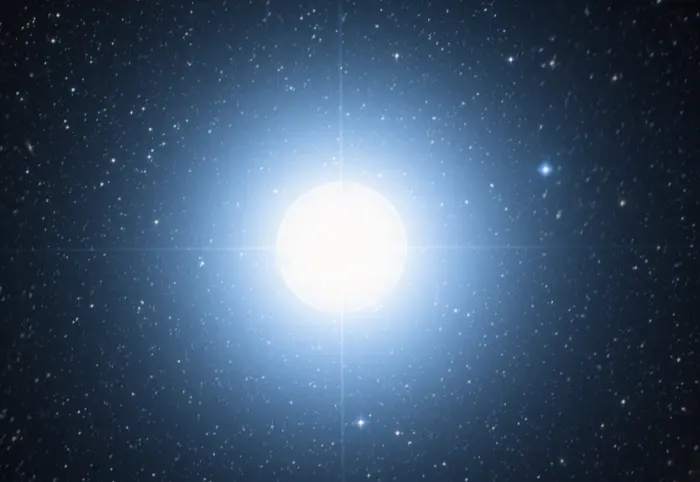
Vega (Alpha Lyrae), image: Wikimedia Commons/Morigan221 (CC BY-SA 3.0)
Vega is a suspected Delta Scuti variable star, one whose variations in luminosity result from both radial and non-radial pulsations of its surface. Vega exhibits both radial and non-radial pulsations. Some parts of its surface contract while others simultaneously expand (non-radial pulsations), and the star also contracts and expands by changing its radius to maintain its spherical shape (radial pulsations).
Also known as dwarf Cepheids, Delta Scuti variables are commonly used as standard candles to establish distances to open and globular star clusters, galaxies, and the Galactic centre. Other bright stars in this class include Altair in the constellation Aquila, Denebola and Zosma in Leo, Caph in Cassiopeia, Tureis in Puppis, Seginus in Boötes, and Polaris Australis (the South Star) in Octans.
Vega completes a full rotation around its axis every 12.5 hours. For comparison, the Sun takes just over 25 days even though it is considerably smaller. Vega spins with an exceptionally high rotational velocity – estimates are as high as 236.2 ± 3.7 km/s along the equator – and, as a result, it is flattened at the poles and has an extended equator.
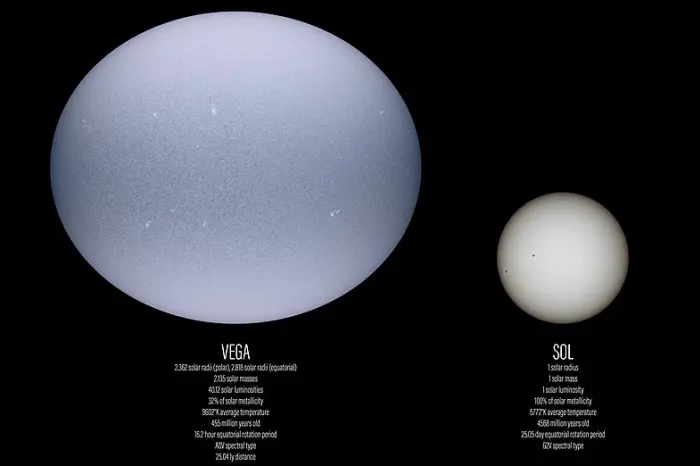
The fifth brightest star, Vega, compared with the Sun (including granulation, gravity darkening, oblateness and bright starspots detected in a 2015 paper. Image credit: Matúš Motlo (CC BY-SA 4.0)
The high spin rate gives Vega the shape of an oblate spheroid. The star’s equatorial diameter is 19% larger than its polar diameter. Vega’s equatorial bulge cannot be observed directly because we only get a pole-on view.
If we could see Vega from its equatorial plane, its spectrum would be about half as luminous because the temperature is lower at the equator than at the poles due to a phenomenon known as gravity darkening. The poles are hotter because they are closer to the centre of mass, while the equatorial region is colder because it is further away from the star’s core.
Gravity at the equator is also weaker than at the poles because the centre of mass is further away. Gravity affects the amount of energy the star radiates and, as a result, there is a significant difference in surface temperature between the poles and the equator. The temperature at the poles is about 17,900° F, while the equatorial surface temperature is only 13,800° F. The poles are said to be “gravity brightened,” while the equator is “gravity darkened.” Achernar, the brightest star in the constellation Eridanus, Altair in Aquila, and Regulus in Leo are other examples of this.
Some of Vega’s light at the equator is blocked by a circumstellar debris ring. Debris disks are sites where planets and planetary systems form. However, no planets have been confirmed around Vega to date. Even if they exist, the star’s short life span makes it unlikely that any complex form of life could develop there.
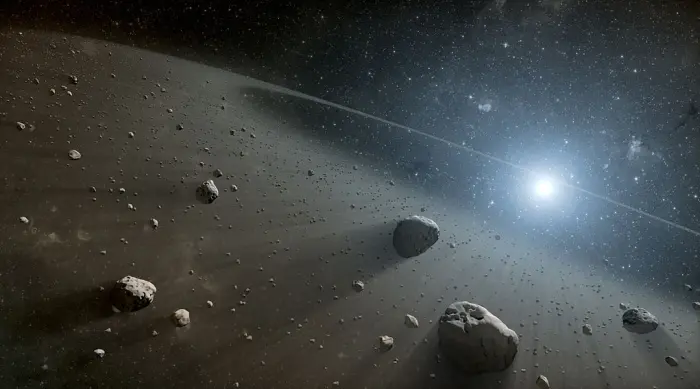
This artist’s concept illustrates an asteroid belt around the bright star Vega. Evidence for this warm ring of debris was found using NASA’s Spitzer Space Telescope, and the European Space Agency’s Herschel Space Observatory, in which NASA plays an important role. Image credit: NASA/JPL-Caltech
In 2013, a team of astronomers led by Kate Su at Steward Observatory at the University of Arizona discovered a large asteroid belt in the Vega system. The discovery makes Vega even more similar to Fomalhaut than previously known.
Like Vega, Fomalhaut lies about 25 light-years away. It is an A-type main sequence star slightly smaller than Vega, with a mass of 1.92 solar masses and a radius of 1.842 solar radii. It has an estimated age of 440 million years. Both Fomalhaut and Vega were once believed to be members of the Castor Moving Group, a disputed stellar association that also included Castor in the constellation Gemini, Alderamin in Cepheus, and Zubenelgenubi in Libra.
Both stars have warm inner belts and cool, comet-filled outer belts that resemble the asteroid and Kuiper belts in the solar system. Fomalhaut’s debris disk was imaged by the James Webb Space Telescope (JWST) in 2023. The wide gap between the debris belts indicates that both stars host multiple planets, which have yet to be detected. The temperature of the inner belt around Vega was measured to be minus 190 degrees Fahrenheit and that of the outer belt, minus 370 degrees.
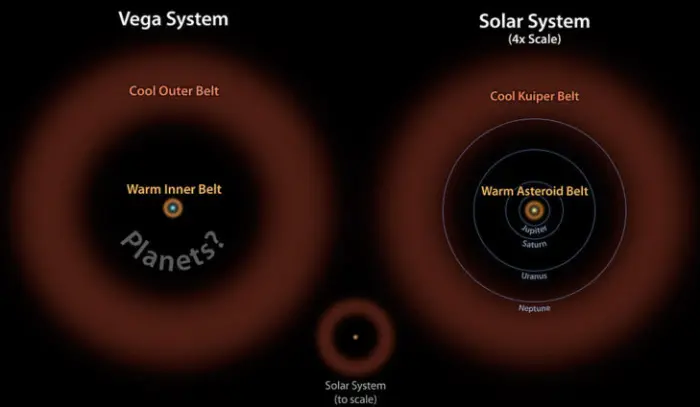
Astronomers have discovered what appears to be a large asteroid belt around the bright star Vega, as illustrated here at left in brown. The ring of warm, rocky debris was detected using NASA’s Spitzer Space Telescope, and the European Space Agency’s Herschel Space Observatory, in which NASA plays an important role. In this diagram, the Vega system, which was already known to have a cooler outer belt of comets (orange), is compared to our solar system with its asteroid and Kuiper belts. The relative size of our solar system compared to Vega is illustrated by the small drawing in the middle. On the right, our solar system is scaled up four times. The comparison illustrates that both systems have inner and outer belts with similar proportions. The gap between the inner and outer debris belts in both systems works out to a ratio of about 1-to-10, with the outer belt 10 times farther away from its host star than the inner belt. Astronomers think that the gap in the Vega system may be filled with planets, as is the case in our solar system. Image: NASA/JPL-Caltech
Planet search
In 1997, the James Clerk Maxwell Telescope discovered a bright central region about 9’’ northeast of Vega. The region appeared as an irregularity in the star’s dust disk. Astronomers have hypothesized that it indicated the presence of a planet. In 2005, they narrowed down the size of the hypothetical planet to 5-10 times the mass of Jupiter.
However, two years later, observations with the Plateau de Bure Interferometer revealed a smooth and symmetric debris disk, without any evidence of the previously reported irregularities. Observations with the Herschel Space Telescope in 2012 confirmed the smooth structure of the disk. Even though there is no evidence of a massive planet, there still may be smaller planets orbiting Vega at a closer distance, where they are more difficult to detect.
A 2021 study reported the detection of a candidate Jovian planet with an orbital period of 2.43 days. The study authors analyzed over 1,500 spectra of Vega taken over 10 years to find periodic radial velocity variations, and they discovered the candidate radial velocity signal. If the planet exists, it has a minimum mass of around 20 Earth masses. The researchers detected another candidate signal that might indicate the presence of a Saturn-mass planet with an orbital period of about 200 days.
Facts
Vega forms the Summer Triangle, one of the brightest and largest asterisms in the night sky with Deneb in the constellation Cygnus and Altair in Aquila. The three stars dominate the evening sky during the northern hemisphere summer. They are easy to identify. Vega appears next to a faint parallelogram that outlines the celestial Harp, Deneb marks the top of the Northern Cross, and Altair is flanked by two other relatively bright stars, Tarazed and Alshain. For northern observers, the Summer Triangle appears high overhead during the summer months.
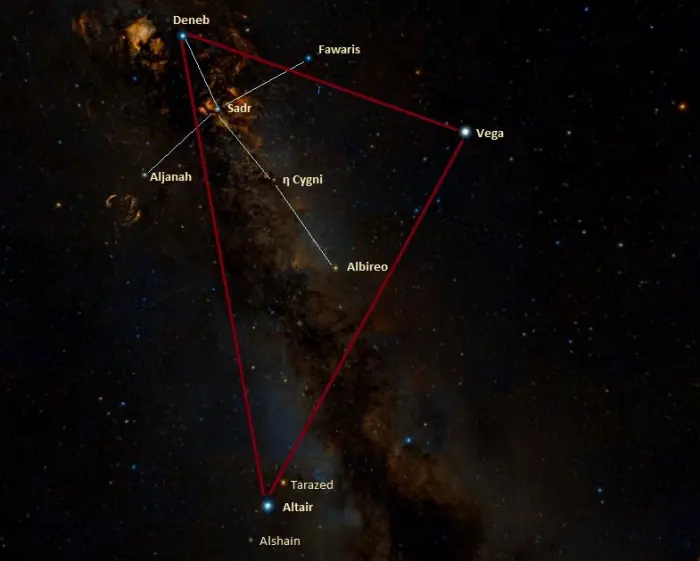
The Summer Triangle and the Northern Cross, image: Wikisky
Vega’s proximity and brightness have made the star a frequent object of study. Vega was one of the first stars to have its distance measured using parallax and the first star outside our solar system to be photographed. It was also the first star to have its spectrum measured.
Vega was first photographed using a 15-inch refractor telescope and the daguerreotype process on July 17, 1850 by William Bond and John Adams Whipple at the Harvard College Observatory. The star’s spectrum was first imaged by amateur astronomer Henry Draper in August 1872. Draper was the first to reveal absorption lines in a star’s spectrum.

The first telescope of the Harvard College Observatory (HCO), “The Great Refractor” was installed in 1847. That telescope was the largest in the United States from its installation until 1867. With it, the first daguerreotype ever made of a star, the bright Vega, was taken by John A. Whipple working under W.C. Bond, following several years of experiments using smaller telescopes. Image credit: John Adams Whipple, 1850
The German-Russian astronomer Friedrich Georg Wilhelm von Struve was the first to measure Vega’s parallax. He gave a value of 0.125 arcseconds, but later revised it, almost doubling the original estimate, after German astronomer and physicist Friedrich Bessel had expressed doubts regarding the data. Struve’s original result was closer to the currently accepted number of 0.129’’, as measured by the Hipparcos satellite. However, as a result of Struve’s revision, it was Bessel who was credited for publishing the first stellar parallax (0.314’’ for 61 Cygni).
Vega is used as a zero point for the colour index, the numerical expression that determines the colour of an astronomical object. Stars that are hotter and bluer than Vega have a smaller colour index, while those that are redder and cooler have a larger one. Vega’s U-B and B-V colour index is set at 0.00.
Vega’s brightness is still used to define zero magnitude for the visible and near infrared parts of the spectrum, with small adjustments. The zero point was originally established by assigning Polaris a magnitude of 2.00, but once astronomers discovered that the North Star was variable, they settled on Vega as the reference star. This is why the Sun, the four other stars that are brighter than Vega – Sirius, Canopus, Alpha Centauri and Arcturus – as well as the planets Venus, Mars and Jupiter, have negative magnitudes.
From Earth, Vega is seen from the direction of one of its poles. For this reason, its projected rotational velocity is much lower (just above 20 km/s) than the more recent measurements indicate. The star is in fact a very fast spinner, rotating at about 90% of its breakup velocity, with estimates of its rotation velocity as high as 236.2 km/s at the equator.
An observer on a hypothetical planet orbiting Vega would see the Sun as a star with a visual magnitude of 4.3 located in the constellation Columba, the Dove.
Vega’s variability was detected in the 1930s, when photometric measurements revealed changes in its brightness on the order of ±0.03 magnitudes. Measurements in 1981 indicated low-amplitude pulsations characteristic of a Delta Scuti-type star.
In 1979, observations with an X-ray telescope revealed that Vega was an X-ray emitter. At the time, Vega was the only main sequence star beyond the Sun known to be an X-ray source.
In 1983, the Infrared Astronomical Satellite (IRAS) detected an excess of infrared radiation coming from Vega. This indicated the presence of a circumstellar disk of dust. Vega was the first star known to have one. The disk extends for hundreds of astronomical units. High-resolution images of the dust were produced by NASA’s Spitzer Space Telescope in 2005. Observations with the Palomar Testbed Interferometer in 2001, the CHARA array in 2006, and the Infrared Optical Telescope Array in 2011 showed evidence of an inner dust band around the star.
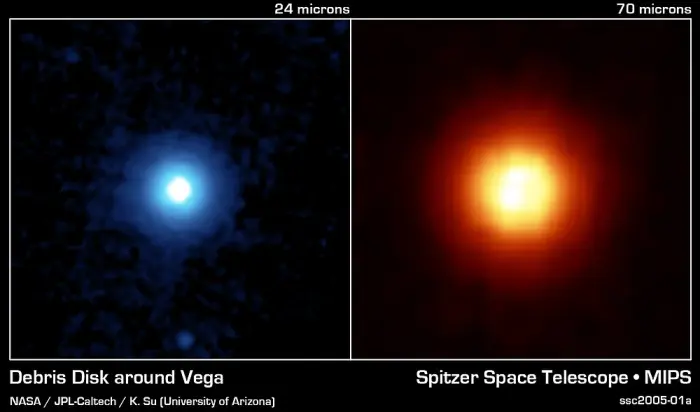
This side-by-side comparison, taken by Spitzer’s multiband imaging photometer, shows the warm infrared glows from dust particles orbiting the star at wavelengths of 24 microns (on the left in blue) and 70 microns (on the right in red). Both images show a very large, circular and smooth debris disk. The disk radius extends to at least 815 astronomical units. (One astronomical unit is the distance from Earth to the Sun, which is 150-million kilometers or 93-million miles). Scientists compared the surface brightness of the disk in the infrared wavelengths to determine the temperature distribution of the disk and then refer the corresponding particle size in the disk. Most of the particles in the disk are only a few microns in size, or 100 times smaller than a grain of Earth sand. These fine dust particles originate from collisions of embryonic planets near the star at a radius of approximately 90 astronomical units, and are then blown away by Vega’s intense radiation. The mass and short lifetime of these small particles indicate that the disk detected by Spitzer is the aftermath of a large and relatively recent collision, involving bodies perhaps as big as the planet Pluto. The images are 3 arcminutes on each side. North is oriented upward and east is to the left. Image: NASA/JPL-Caltech/K. Su (University of Arizona)
Vega was also the first class A star (that is not Ap chemically peculiar) known to have a magnetic field. In 2015, it became the first normal class A star known to have star spots on its surface.
Vega has an unusually low metallicity and observations suggest that it is a weak Lambda Boötis star, a chemically peculiar star with a very low abundance of iron peak elements in its surface layers. There is no clear explanation for the existence of such stars.
Vega’s proper motion is slowly taking the star toward Earth. The star will make its closest approach in about 264,000 years, when it comes within 13.2 light years (4.04 parsecs) of the Sun. Around the year 210000 CE, Vega will take over from Sirius as the brightest star in the sky. It will lie at a distance of 17.2 light years and shine at magnitude -0.81.
Vega is one of the 58 bright stars that have been given a special status in the field of celestial navigation. Navigational stars are some of the brightest and most recognizable stars in the sky. Polaris, Deneb and Altair also belong to this group.
Vega was the North Pole star – the nearest visible star to the north celestial pole – around 12000 BCE and will be again around 13700 CE, when precession of the equinoxes takes it within 5° of true north. It was and will be the Earth’s brightest North Star. Polaris (Alpha Ursae Minoris), the current North Star, is only the 48th brightest star in the sky.
Vega is associated with the Lyrids, a meteor shower that can be seen from April 16 to April 26 each year. The shower peaks around April 22 with 5 to 10 meteors per hour. The radiant of the Lyrid meteor shower is located near the star and the meteors appear to come from Vega’s direction, but this is just a line-of-sight coincidence. The true source of the meteor shower is the long-period Comet C/1861 G1 Thatcher. The particles of dust left behind by the comet that burn up in the Earth’s atmosphere are only about 100 km away.
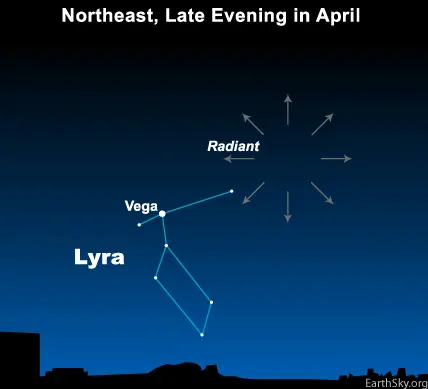
The radiant point of the Lyrid meteor shower, image credit: Bruce McClure and Joni Hall, EarthSky.org (CC BY-SA 3.0)
In medieval astrology, Vega was considered one of the 15 Behenian fixed stars. These stars were believed to be a source of astrological power for one or more planets and considered useful for magical applications. Vega was associated with Mercury and Venus and linked to winter savory and chrysolite. Astrologers believed that it gave artistic talent, aspirations for status and influence, high success, refinement, and a tendency for debauchery.
Like most exceptionally bright stars, Vega has been used or referenced in countless works of fiction. The best-known uses and mentions include Foundation (1951) by Isaac Asimov, Alfred Bester’s The Stars My Destination (1956), Robert A. Heinlein’s Have Space Suit – Will Travel (1958), Roger Zelazny’s This Immortal (1966), Carl Sagan’s Contact (1985), Dan Simmons’ Hyperion (1989) and The Fall of Hyperion (1990), and Greg Egan’s Diaspora (1997).
Name
The name Vega (once also spelled Wega) derives from the Arabic wāqi‘, which means “falling” or “landing.” It was taken from the phrase an-nasr al-wāqi‘, meaning “the swooping eagle” or “the falling eagle.” The name was officially approved for Alpha Lyrae by the International Astronomical Union’s (IAU) Working Group on Star Names (WGSN) on June 30, 2016.
The star’s Arabic name appeared in Egyptian astronomer Mohammad Al Achsasi Al Mouakket’s star catalogue, written circa 1650, and was later translated into Latin as Vultur Cadens, meaning “the falling eagle (or vulture).” Lyra constellation was depicted as a vulture by ancient Egyptians and was similarly represented as a vulture or eagle in ancient India.
In the western world, the name appeared in the Alfonsine Tables, compiled in Spain in the mid-13th century. Medieval astrolabes (inclinometers used to measure stars’ altitude above the horizon) in Europe depicted the star as a bird and called it Wega or Alvaca.
The Chinese name for Vega is the First Star of Weaving Girl (織女一). It refers to the asterism known as the Weaving Girl, formed by Vega with Epsilon Lyrae and Zeta1 Lyrae.
In Chinese lore, Vega and Altair are associated with the myth of Qixi (Qi means “seven” and Xi means “night”) and the Qixi Festival (Seventh Evening Festival). The festival is traditionally held on the seventh day of the seventh month on the Chinese lunar calendar to celebrate the annual meeting of Niulang (the cowherd, represented by Altair) and Zhinü (the weaver girl, represented by Vega). In the story, the two lovers are separated by a large river, represented the Milky Way, and can only meet once a year, when magpies create a bridge across the celestial river so that the lovers can briefly be together again.
The legend is more than 2,600 years old. It also inspired the Tanabata festival in Japan and the Chilseok festival in Korea. The Tanabata festival celebrates the meeting of Orihime (Vega) and Hikoboshi (Altair), while the Korean event is associated with the folktale of Jiknyeo (the weaver girl) and Gyeonwu (the herder).
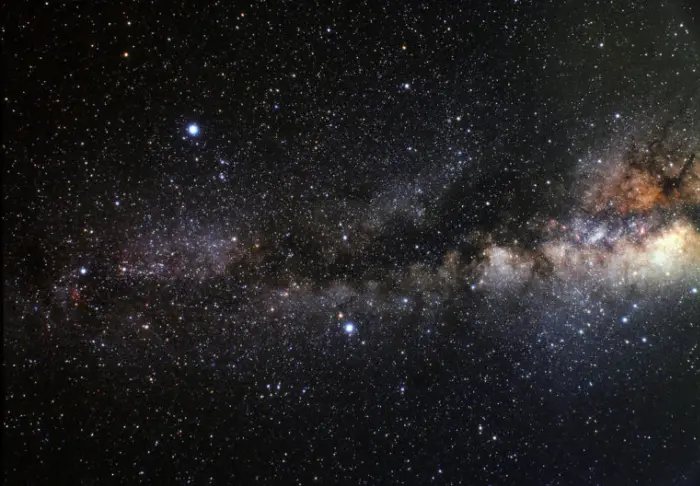
The Summer Triangle with Vega (top left), Altair (lower middle) and Deneb (far left), image: NASA, ESA. Credit: A. Fujii
To the ancient Greeks, Vega symbolized the handle of Orpheus’ harp, while the Romans based the start of the autumn season on the hour of the star’s falling below the horizon. Assyrians called the star Dayan-same, meaning “the judge of heaven,” and Akkadians knew it as Tir-anna, or “life of heaven”.
In ancient Babylonian culture, Vega may have been one of the stars known as Dilgan, or “the messenger of light.” In Hindu mythology, the star is known as Abhijit, meaning “the victorious one” or “the undefeatable one.” In the Mahabharata, Krishna says that he was born under this nakshatra (lunar mansion associated with the star).
In northern Polynesia, Vega was known as whetu o te tau, which means “the year star”. It once marked the beginning of the new year, before the function was assigned to the Pleiades cluster.
In northwestern Victoria in Australia, the Boorong people called Vega Neilloan, or “the flying loan,” referring to the ground-dwelling Australian malleefowl. The Lyrids represented the scratchings of the malleefowl during the nest-building season.
Location
Vega is relatively easy to find because it marks the northwestern vertex of the Summer Triangle, a bright, large asterism that dominates the evening sky during the northern hemisphere summer. The other two stars that form the asterism are Deneb, the brightest star in Cygnus, the Swan, and Altair, the brightest star in Aquila, the Eagle, located opposite Cygnus.
Vega is part of the recognizable constellation figure of Lyra. It appears next to a small parallelogram formed by Sheliak, Sulafat, Delta and Zeta Lyrae, which lies between Vega and Albireo at the Swan’s beak. Sheliak and Sulafat (Beta and Gamma Lyrae) can be used to find the Ring Nebula (Messier 57), a bright planetary nebula in Lyra.
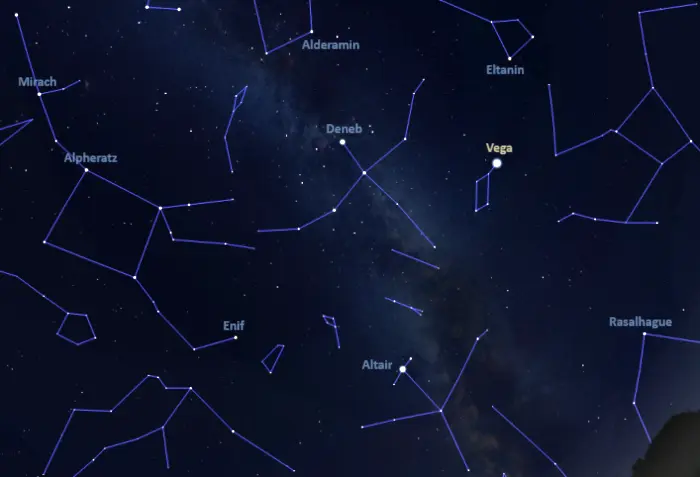
Vega location, image: Stellarium
Vega is circumpolar and can be seen throughout the year from locations north of the latitude 51°N. It is visible from all locations north of the latitude 51°S. From the mid-northern latitudes, the star can be seen near the zenith in the evening during the northern hemisphere summer, while observers in the mid-southern latitudes can see it low above the northern horizon during the southern hemisphere winter.
Constellation
Vega is located in the constellation Lyra. Lyra is a relatively small constellation, sandwiched between the larger Cygnus and Hercules. Vega stands out in this part of the sky as the brightest of the stars that form the constellation’s distinctive lyre-shaped asterism. Sulafat, Lyra’s second brightest star, is considerably fainter, with a visual magnitude of 3.261.
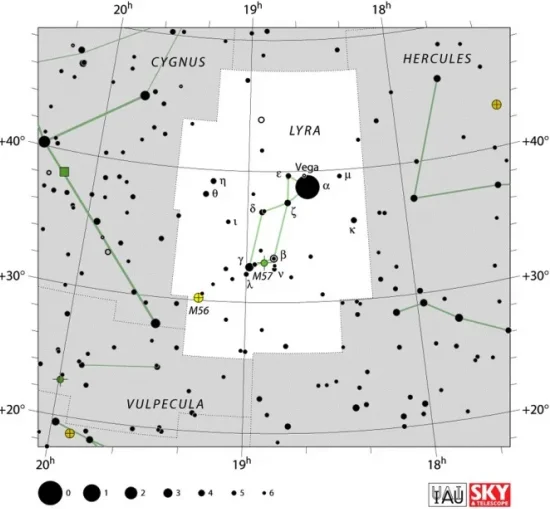
Lyra constellation map by IAU and Sky&Telescope magazine
In Greek mythology, Lyra represents the lyre of the mythical Greek musician and poet Orpheus. The constellation is a popular telescope target because, despite its size, it contains several interesting stars and deep sky objects. Notable stars in the constellation include the variable stars Beta Lyrae, R Lyrae and RR Lyrae, the visual double Delta Lyrae, and the multiple star system Epsilon Lyrae, popularly known as the Double Double.
Interesting deep sky objects in Lyra include the planetary nebula Messier 57 (the Ring Nebula), the bright globular cluster Messier 56, the open cluster NGC 6791 and the interacting triplet of galaxies designated as NGC 6745.
The best time of the year to see the stars and deep sky objects in Lyra is during the month of August, when the constellation is high overhead in the evening for northern observers. The entire constellation is visible from locations north of the latitude 40° S.
The 10 brightest stars in Lyra are Vega (Alpha Lyrae, mag. 0.026), Sulafat (Gamma Lyrae, mag. 3.261), Sheliak (Beta Lyrae A, mag. 3.52), R Lyrae (mag. 4.00), Delta2 Lyrae (mag. 4.22), Kappa Lyrae (mag. 4.35), Zeta1 Lyrae (mag. 4.34), Theta Lyrae (mag. 4.347), Aladfar (Eta Lyrae, mag. 4.40), and Epsilon2 Lyrae A (mag. 4.59).
Vega – Alpha Lyrae
| Spectral class | A0Va |
| Variable type | Delta Scuti |
| U-B colour index | 0.00 |
| B-V colour index | 0.00 |
| Apparent magnitude | +0.026 (−0.02 to +0.07) |
| Absolute magnitude | +0.582 |
| Distance | 25.04 ± 0.07 light-years (7.68 ± 0.02 parsecs) |
| Parallax | 130.23 ± 0.36 mas |
| Radial velocity | -20.60 ± 0.2 km/s |
| Proper motion | RA: 200.94 ± 0.32 mas/yr |
| Dec.: 286.23 ± 0.40 mas/yr | |
| Mass | 2.135 ± 0.074 M☉ |
| Luminosity | 40.12 ± 0.45 L☉ |
| Radius | 2.362–2.818 R☉ |
| Temperature | 9,602 ± 180 K (8,152–10,060 K) |
| Metallicity | −0.5 dex |
| Age | 455 ± 13 million years |
| Rotational velocity | 20.48 ± 0.11 km/s |
| Rotation | 16.5 hours |
| Surface gravity | 4.1 ± 0.1 cgs |
| Constellation | Lyra |
| Right ascension | 18h 36m 56.33635s |
| Declination | +38° 47′ 01.2802″ |
| Names and designations | Vega, Alpha Lyrae, α Lyr, 3 Lyrae, Wega, HD 172167, HR 7001, HIP 91262, SAO 67174, BD+38°3238, GJ 721, AG+38 1711, FK5 699, LTT 15486, NLTT 46746, PPM 81558, GCTP 4293.00, GC 25466, GCRV 11085, CCDM J18369+3847A, JP11 2999, UBV 15842, IRAS 18352+3844, 2MASS J18365633+3847012, TYC 3105-2070-1, CCDM J18369+3847A, ADS 11510 A, IDS 18336+3841 A, WDS J18369+3846A |